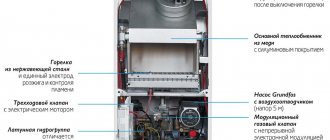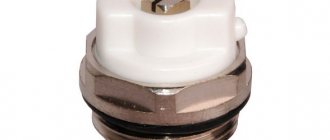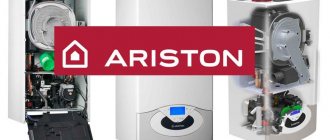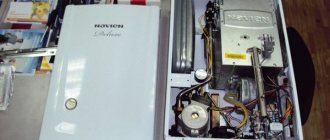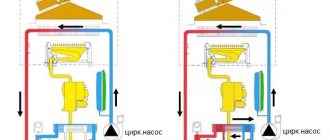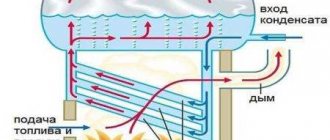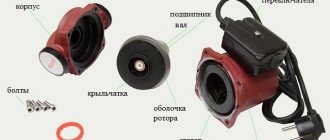Cold batteries in winter are an emergency that requires an immediate solution. To fix serious problems, you should hire specialists, but some problems can be dealt with on your own. Even if the owner of an apartment or house does not intend to repair the heating on his own, it will not hurt him to know about the signs and causes of malfunctions.
Signs and causes of poor heating performance
| Characteristic signs | Possible reasons |
| The riser is cold | Technical faults outside the apartment |
| The riser is hot, the batteries are cold | Valves are closed, heating system is clogged |
| Cold bottom of radiator | Valves are not open enough, radiators are clogged, low coolant pressure in pipes |
| Cold top of batteries | Airlock |
| The last radiator in the system is cold | System not adjusted, insufficient pressure |
| The part of the radiator farthest from the connection pipes is cold | Insufficient pressure, clogged battery, air lock |
An analysis of the events preceding their occurrence will help identify the causes of malfunctions.
| Work carried out, operating features | Possible faults |
| Replacement of heating devices, pipes | Air lock due to air entering the system or changes in pipe slopes. Clogged pipes and radiators. Reduced flow areas due to errors during system assembly |
| The heating system works without maintenance for many years | Scale has formed, the heat transfer of the batteries has deteriorated, and parts of the shut-off valves have become “stuck” |
| Start of the heating season | The boiler room did not reach its design capacity, employees of the relevant services forgot to open the valves, and air pockets formed when the system was filling. |
| Neighbors were doing renovations | Reduced pressure in the system due to unprofessional actions of neighbors |
First of all, if the heating is poor, interview the residents of the house. If they have the same problem, it means that the boiler room is not working well or the valves in the basement of the house are closed. In these cases, you should jointly contact the management company. If only one apartment is cold, check that the valves are open and there are no air pockets. Call a specialist through the dispatcher of the organization serving the house.
Clogged heating system riser
A clogged heating system riser in an apartment building is determined by the cooling of heating radiators in several apartments. Typically, such radiators can be located vertically one below the other, depending on the configuration of the specific heating system. Usually, with such a breakdown, the upper floors receive enough heat, and the lower floors freeze. This is especially noticeable when there is a strong minus on the street.
The reasons that lead to clogging of the riser are usually laid down at the installation stage. A decrease in the diameter of the riser pipe by 0.25 compared to the design one leads to clogging with oxides and debris after just a few years.
Removing such a clogged system riser usually requires the work of a qualified team of plumbers. Often, such repairs also require the consent of other residents, including apartments that are not directly affected by the emergency.
Basic malfunctions of heating systems and their elimination
Air jams
Air pockets occur in radiators and pipes and interfere with the normal circulation of water in the heating system. They appear for various reasons:
- violation of the technology for filling the system with water after the summer period;
- non-compliance with water deaeration regime;
- performing repairs with disassembling pipelines;
- failure to observe slopes when installing the heating system;
- air leakage through leaky joints.
To remove air from the system, use a Mayevsky valve installed on the radiator. You should open it, wait until the air comes out, the hissing stops, and the water begins to pour out calmly without bubbles. After this, the valve is closed. Don't forget to provide a container or towel to drain the water.
Old cast iron batteries do not have Mayevsky taps. The air is released without completely unscrewing the plugs at the ends of the radiators. It is better to entrust this operation to plumbers - if you unscrew the plug completely, you can flood the apartment.
Malfunctions of shut-off valves
Valves may be in the closed position, and control devices may be incorrectly configured.
Malfunctions of the shut-off valves cannot be ruled out. If the riser is hot and the radiators are cold, you should check the position of the valves - at the entrances to the radiators they should be open, at the jumper between the supply and drain they should be closed. Over time, valve parts become covered with scale and dirt. Leaks occur or the valve does not turn at all. An inspection of the faucet will help to clean the parts from deposits. A radical solution to the problem is to completely replace the entire device or the valve head.
Clogging
When the system is clogged, pipes and radiators become completely or partially clogged with various deposits. A sign of blockage is dirty water from Mayevsky’s tap. Scale on the internal surfaces of radiators has heat-insulating properties and reduces the heat transfer of heating devices. To clean batteries:
- remove;
- disassembled into sections;
- placed in a bathtub on a soft bedding;
- washed with a stream of water under pressure;
- fill with a solution of vinegar or soda ash;
- perform repeated washing;
- assembled and installed.
Cleaning dirty pipes requires special equipment. This work should be entrusted to specialists.
Insufficient pressure in the system and low coolant temperature
When the risers are lukewarm, the coolant is at a low temperature or is supplied under insufficient pressure. The reasons may be:
- actions of neighbors to “improve” the heating system (exceeding the calculated diameter of pipes, the number of radiator sections, changing the connection diagram, installing water-heated floors);
- incorrect position of valves in heat supply networks;
- poor boiler room performance.
In any of the described cases, you cannot cope with the problem yourself - you should contact the management company.
Incorrect heating system setting
A sign of incorrect settings of the heating system is different temperatures of the batteries connected to the same riser. Most of the coolant enters one radiator, the other remains cold. To eliminate the problem, open the valve more on a cold battery and close it a little on a hot one. If there is no change, the cold radiator is probably clogged.
Fixing problems
Diagram of water supply to batteries
Repairing a sewer riser yourself is quite problematic. Especially if you don’t know anything about this kind of work. In addition, if any malfunctions are detected, you should immediately contact the relevant organizations. That is, to those who are responsible for your home, or directly to the organization that is responsible for heating.
If they tell you that they know nothing, the reasons are incomprehensible to them, then you have the right to express everything you think about them. Remember, they are obliged to resolve such issues at the request of the client. After all, it turns out that the heating season begins, you supposedly receive your heat (although for one reason or another it does not reach the water supply risers), and therefore a corresponding debt for utilities accumulates. In other words, although there is no heat, you have to pay for it.
In this regard, are you really obliged to wait several days until the plumbers come, figure out the reasons, and take certain actions? No, you must demand immediate repairs.
Causes and their elimination
Heat map of a radiator that is most likely bloated
Before the relevant specialists come to you to resolve the current situation, it would be a good idea to obtain additional information about the operation of the water supply riser and sewer riser in order to provide the specialists with the relevant data. Based on them, perhaps they will be able to find the reason for the lack of heat in your home much faster.
- How well do the batteries warm up on other water supply risers located in your apartment?
- How well the batteries warm up on your own riser, but only those of the neighbors below;
- How well the radiators of the neighbors in the adjacent entrances heat.
Now you can consider each of the situations in more detail, which will allow you to determine the causes of the malfunctions, as well as find a way to solve the problem.
- When the radiators in other rooms of your apartment heat normally, and the apartments below and above are heated well, it means that the valves at the inlet or outlet of the radiator may be faulty, which does not heat well. There is also a possibility of blockage in the outlet and inlet pipes. Finally, don't rule out that the battery itself is clogged.
- If the battery does not heat well, and neighbors below and above have problems on the same riser, then the reason is the blockage or malfunction of the corresponding valves located in the basement. Another option is clogged return or direct riser pipes.
- It also happens that water supply risers receive insufficient flow of water, that is, coolant, which is why heating is not carried out completely throughout the house or in a separate entrance. Consequently, an increase in pressure is already necessary here.
Air jams
Quite often, heating risers and sewer risers cannot provide heat to your home because an air lock has formed. It is formed there quite naturally when the water is heated and the system is suddenly filled with coolant. If there is a bleeder valve on the system, it will not be difficult to determine the presence of an air lock. On modern batteries, this valve is on top and works autonomously, releasing excess air from time to time.
In the absence of automation, a manual valve is provided, which is unscrewed and kept open until water flows.
Alas, older models are not equipped with taps. But there is a plug there, which will not be so difficult to remove. Just be sure to place some kind of container under it to prevent water from spilling onto the floor. Do not unscrew the plug completely, but only unscrew it until a hissing sound appears. As soon as a similar sound begins to come out of the system, put the instrument aside and wait until the air comes out and water starts flowing. When water has seeped out, carefully tighten the cap, but do not remove the basin for a couple of hours in case the water continues to drip for a while.
Heating faults in private houses
Autonomous heating systems of private houses have their own characteristics and are characterized by specific malfunctions.
Problems with the boiler
The most common problems are related to the incorrect operation of the built-in automation system. If you cannot adjust the automation yourself, contact a company that provides service for boilers of this type.
The automation system will not allow the boiler to turn on if there is insufficient draft (the chimney is clogged with soot) or low pressure in the system. To eliminate the causes, you should clean the chimney, check the water level in the expansion tank and the operation of the circulation pumps.
Another cause of problems is insufficient boiler power. Symptom: the automatic system does not turn off the boiler; it works constantly. The solution is to replace the boiler with a more powerful one.
Wrong choice of heating system
Single-pipe heating systems are cheaper than double-pipe heating systems, but are only suitable for heating small houses. The last battery from the boiler will be colder than the previous ones. This problem can only be eliminated by replacing the system with a two-pipe one.
Other problems are similar to malfunctions of heating systems in apartment buildings and are discussed above.
Clogged water filter of the heating system
Sometimes there is an arbitrary decrease in the temperature of the “last” battery in the row. Then it is possible to cascade shutdown of other batteries in front of it. Typically, the reason for such an “abnormal” decrease in temperature is the filters of the heating system. This filter must be removed and cleaned thoroughly. During the first start-up, there may be debris in the water that is pumped into the heating system. To prevent this debris from entering the heating boiler heat exchanger, a filter is installed on the return pipe in front of the boiler. Usually one such filter is installed, but sometimes you can see several installed almost in front of each battery. This setup doesn't make any sense. After cleaning, the radiators in the house will no longer be cold.
Preventing heating problems
Preventative work should be performed in the summer. It is better to combine them with major or current repairs. For the heating system to work properly, you need to:
- analyze the heating operation in the previous winter, find weak points;
- check the operation of shut-off valves, repair or replace faulty ones;
- if Mayevsky taps or valves for supplying coolant to heating devices are missing, they should be installed;
- check the slopes of the supply pipes, eliminate violations, if this is not possible, install Mayevsky taps in problem areas;
- flush or replace radiators that did not heat up enough during the previous heating season.
Prepare your heating system for operation in the summer and the likelihood of failures will be greatly reduced.
